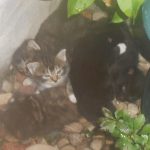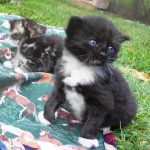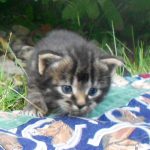With my husband’s help, I feed a migrant community of feral cats. Twice daily, we greet 1 black cat and 3 tortoise shell cats at the food pans in the bushes. Sometimes there is a black and white one, and sometimes an orange or tiger stipe cat and we can tell you their ancestry going back 5 generations.
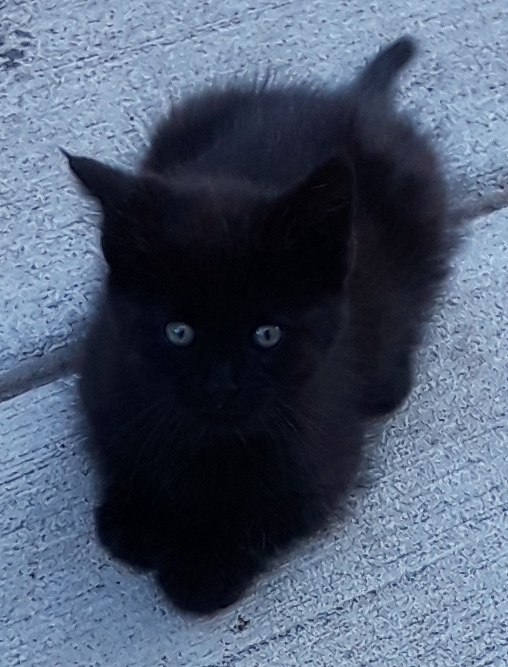
I’m not bragging about this, and frankly, I wish I didn’t have to talk about this at all. We came upon this cat population accidentally and now we’re trying to work our way out of it.
I came to know about feral cats because I am an avid gardener and animal lover. When I first discovered a little black kitten living in my garden under the Hostas, it was natural to want to feed him. He wasn’t friendly, and always ran when he caught sight of me, but he looked hungry, so I left food out for him. He was black, so we called him Midnight. He stuck around all that first summer and showed up periodically over the following winter. When summer came, Midnight disappeared and that was when a funny thing happened.


To my surprise the Hosta’s revealed a whole litter of kittens! They were tiny, and no sign of mamma cat but I figured she was around somewhere.
We left food out for the mamma kitty, and eventually we were able to handle the kittens with mamma nearby. Just as we were about to catch the whole bunch of them for re-homing, mamma kitty disappeared and took all the kittens with her. Later that year when it got cold, Midnight and Mamma kitty returned and we fed them intermittently as they showed up.
It seemed that my garden was growing kittens. Year after year, kittens were born in the spring and the challenge was to find them and rehome them before the mamma cat disappeared. Whenever we found them, the mamma would move them to a new spot. She often put them under the prickly bush on top of a pile of rocks. This seemed inhumane, so I went online to order a cat house where litters could live until they were old enough to re-home.
At the end of the order form, it said “personalize your house for no extra charge”. I didn’t have a particular cat’s name to put on the house, but my daughter had a great idea. And that is how the Halfway House came to be located in my lilac bushes.
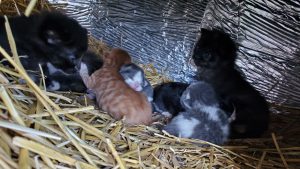

Feral Cat Facts and FAQs
- Feral cats are domestic cats that were born and raised with little or no contact with people
- Feral cats are not stray cats. Strays are homeless pet cats, while ferals were born in the wild, and were never socialized to humans. They are usually unseen by humans.
- These feral cats have highly developed instincts for survival, so they are extremely fearful of people. You don’t see them, but they are there in all communities.
- Many people believe that cats can fend for themselves. Cat owners often abandon their cats when they move or simply no longer want the responsibility of pet ownership. Those cats survive only if they find food, shelter, and avoid dangers such as injury from cars, dogs, other cats, or abusive humans.
- Feral cats often live in colonies, forming groups around food sources.
- They are rarely spayed, neutered or vaccinated, and their offspring are raised without human contact. Within a few years, one or two cats can produce a colony of twenty or more.
- Feral and stray cats live difficult lives as they are susceptible to disease, starvation and the freezing conditions of trying to survive a Minnesota winter. Left on their own, they breed future generations of feral who live the same difficult lives.
- The can also spread disease and harm native bird populations thru predation.
- Killing feral cats does not reduce their numbers, as studies show new feral cats will soon take up their place.
- There are two humane ways of controlling the feral cat population. One is by TNR – Trapping, Neutering and Returning them to where they were trapped.
- The other is trapping and euthanasia.
- Feral cats can have happy healthy lives outdoors. Humans can help that by TNR’ing feral cats.
- Since house cats can sneak outdoors, you should always vaccinate, spay and neuter your pets and keep them indoors.
- If you feed feral cats, you have to TNR, to prevent overpopulation.
My journey from Midnight to the Halfway House has taught me much about feral cats. Over the past several years we have re-homed over 25 kittens. They have all made wonderful pets.
Now we have a colony of 4 female cats and it is too many. We have since learned that there used to be funding in our area that allowed a local animal rescue to feed the feral cats and spay/neuter and vaccinate them. As the funding dried up and disappeared the cats made their way to our neighborhood, which is close to the river so they have a water source and close to a restaurant which may provide garbage to eat. When two others on the block moved and stopped feeding the cats, they found their way to our house.
I came to know about feral cats by chance encounter with one tiny kitten. You should care about feral cat populations because they could pass disease to people and pets, they can harm the native bird population and they are attracting other predators like coyotes and eagles into city limits. They are in every neighborhood whether you see them or not and even whether you feed them or not.
What we can do about feral populations is to Trap, Neuter and Release back where they were trapped. By doing the TNR, we can keep our population static instead of increasing until it eventually decreases due to the age of the cats. Vaccinate, spay and neuter your indoor cats and keep them indoors. A brief escape can produce kittens.
The best place for a cat is indoors with a loving family.
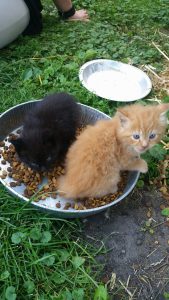
Hungry 
4 weeks old 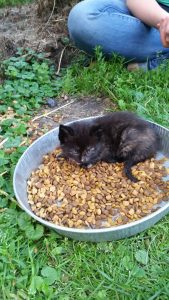
Getting tame

